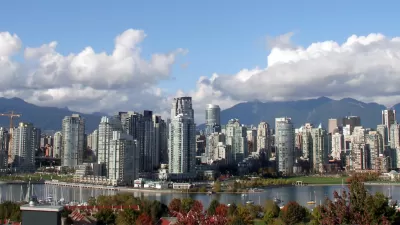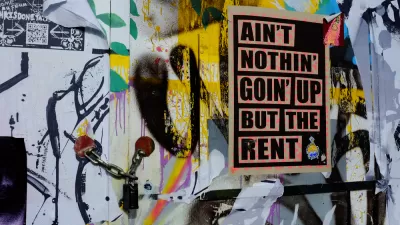Rebutting arguments against the law of supply and demand.

Throughout the United States, rents (and in some cases housing prices) have been skyrocketing over the past several years. Under the economic law of supply and demand, one* obvious answer to this crisis is: expand supply (by which I mean, eliminate zoning regulations that prevent landowners from building more apartments.) The latter argument, of course, has met a lot of resistance from a variety of quarters. Some months ago, I critiqued what I called "supply and demand denialism."
But since then, I've heard a variety of interesting new arguments on this point, which I would like to address in this blog post.
Argument 1: "Where land costs are high, housing costs will always be expensive." I am not persuaded by this argument, for two reasons. First, the cost of land is not the same as the cost of housing. For example, suppose that the cost of land costs $5 million per acre. Does that mean that no housing unit can cost less than $5 million? Yes, if the government only allows one housing unit to be built. But if government allows ten housing units to be built, the landowner can sell each for $500,000 and break even. And if the government allows 100 housing units to be built, the landowner can sell each for $50,000 and break even. So if people were allowed to build more housing units, the price of housing would come down—high land costs or no high land costs.
Second, as long as some land is zoned for uses other than housing, the supply of land is not static, and, thus, the cost of land is not static. Government could zone additional land for mixed uses (or just for housing), effectively creating more land.
Argument 2: "Greedy developers build only for rich people."** But this argument begs the question: why is it that developers build only for rich people in New York but build for middle-class people in Pittsburgh or Indianapolis? Are the developers any less greedy there? Of course not! High housing costs mean that developers can get more money for their housing in New York. So this argument creates a vicious circle: government regulation causes a housing shortage, causing high housing costs, causing developers to charge more for new housing, causing citizens to use this very fact as a reason not to allow new housing, causing the housing shortage to get even worse.
More importantly, most housing units aren't new units. When I lived in Manhattan, I lived in a gentrifying zip code (10018) with high rents and newer housing than many other neighborhoods. But even there, my last Zillow.com search found that only 9 of 47 available rentals were built before 2000. So rather than asking "why are new units more expensive?", perhaps we should be asking "why are older units so expensive?"
It seems to me that when the number of new units is restricted, only the most affluent renters can afford them. This in turn means that the upper middle class and the "ordinary rich" are then forced into the older unit market. They bid up the price of older units, forcing up the price of older units. By contrast, if more new units were permitted, the “ordinary rich” and the upper middle class could afford them, making older units more affordable for everyone else. To put it another way, if there were more newer units on the market, the aging walk-ups that now cost $2000 a month might cost, say, $1500 or $1000 per month or even less.
A variation of this argument is that "greedy developers only build condos." I'm not sure I find this persuasive because condominia and apartments aren't completely separate markets. Condos can sometimes be rented, and condos and rental units compete with each other because if condos are abundant enough and cheap enough, people who would otherwise rent buy condos (thus causing less price pressure on rentals, causing rents to become cheaper). So I'm not sure whether this argument changes the underlying economic rules.
A third argument that I mentioned, but did not address as fully as I could have, is the claim that new housing raises housing costs by making a neighborhood more desirable. This argument assumes that gentrification follows new housing, rather than vice versa. Although more research on this issue would be useful, it seems to me that the reverse is often the case: historic neighborhoods throughout the country have been gentrifying over the last decade or two,*** and new housing follows the gentrification when zoning permits it. For example, in Greenpoint (one of Brooklyn’s most rapidly gentrifying areas) about half of all housing was built before 1950, while newer areas on Brooklyn's outskirts are not doing so well.
In sum, it seems to me that, in a world with less zoning, fewer density regulations, and more building, rents would eventually stop exploding—and that neither land costs nor the existence of rich people necessarily prevents that.
*But not the only one. Another alternative is to build huge amounts of public housing- perhaps not a bad idea. But given the dismal reputation of public housing, the unusually high tax levels of some of the most expensive cities, and the high level of taxophobia in the United States, I cannot imagine this happening anytime soon.
**Not dissimilar to "greedy developers only build for rich foreigners," critiqued here.
***See generally William Lucy's book "Tomorrow's CIties, Tomorrow's Suburbs" (pre-1940 neighborhoods experiencing greater income gains than postwar suburbs).

Planetizen Federal Action Tracker
A weekly monitor of how Trump’s orders and actions are impacting planners and planning in America.

Maui's Vacation Rental Debate Turns Ugly
Verbal attacks, misinformation campaigns and fistfights plague a high-stakes debate to convert thousands of vacation rentals into long-term housing.

San Francisco Suspends Traffic Calming Amidst Record Deaths
Citing “a challenging fiscal landscape,” the city will cease the program on the heels of 42 traffic deaths, including 24 pedestrians.

Defunct Pittsburgh Power Plant to Become Residential Tower
A decommissioned steam heat plant will be redeveloped into almost 100 affordable housing units.

Trump Prompts Restructuring of Transportation Research Board in “Unprecedented Overreach”
The TRB has eliminated more than half of its committees including those focused on climate, equity, and cities.

Amtrak Rolls Out New Orleans to Alabama “Mardi Gras” Train
The new service will operate morning and evening departures between Mobile and New Orleans.
Urban Design for Planners 1: Software Tools
This six-course series explores essential urban design concepts using open source software and equips planners with the tools they need to participate fully in the urban design process.
Planning for Universal Design
Learn the tools for implementing Universal Design in planning regulations.
Heyer Gruel & Associates PA
JM Goldson LLC
Custer County Colorado
City of Camden Redevelopment Agency
City of Astoria
Transportation Research & Education Center (TREC) at Portland State University
Jefferson Parish Government
Camden Redevelopment Agency
City of Claremont






























